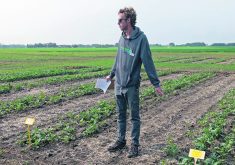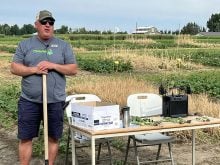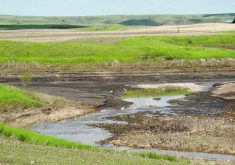The practice causes less erosion compared to full tillage, but allows soil to warm up faster compared to direct seeding
The wind that blows across southern Alberta provides a welcome relief to sub-zero temperatures during winter, when Chinooks can turn double-digit negative temperatures to positives. But those same winds can be a menace when it comes to protecting topsoil.
Strip tilling is seen as part of the solution to prevent soil from leaving the farm and keeping it out of irrigation canals.
It comes with challenges, according to John Kolk, who farms near Lethbridge. It’s costly to get started, he said, because it requires specialized equipment and precision accuracy to till the narrow strips where seed will be planted.
“That’s probably one of the reasons people won’t get into it. It’s just another cost that way,” he said. “And we don’t have the support for strip till from government for sure. We don’t have the (equipment) sellers and whatnot that know how to handle it.”
Kolk said there have been attempts in the past in Canada to develop the specialized implements, but the practice hasn’t caught on enough for equipment manufacturers to continue.
He said strip tilling works by creating a washboard effect that can trap the soil in the field rather than letting it blow across the prairie.
“The trick to erosion is either you got big enough lumps or trash on top or something to break the wind. You want to slow the wind speed down at the surface,” said Kolk. “When you strip till, you are leaving 12 to 16 inches of undisturbed stubble and the wind doesn’t dip into that, goes over top and then it’s quite a significant improvement.”

The issues with erosion in the region have become significant enough to warrant warnings from rural municipalities and irrigation districts because of the buildup of soils in culverts and canals.
“If you don’t deal with wind erosion, you are cleaning out ditches. No farmer wants to see the nutrients go next door or any of the residue. Nobody likes wind erosion but you get a year with some tight freeze-thaw cycles, lots of wind and no moisture, you have a problem,” said Kolk. “That’s why strip till is very attractive to me as an option.”
During a crop tour of a seed canola field test hosted by Farming Smarter, researcher Lewis Baarda, presented the results of the comparisons of direct seeding, full till and strip till.
Researchers planted the three treatments on the same spring day this year.
As far as the differences, “strip till is performing as good as anything else,” said Baarda. “We didn’t see a lot of difference between treatments.”
That is when it comes to yields.
When it comes to erosion, “that is one of the big ones,” said Baarda. “When it comes to strip till, you are not tilling the whole field, just these stripes in between and hitting the best of both worlds with tilling. You are tilling a maybe four- to six-inch seed bed where you are going to place the seeds but in between that, you still have that crop cover, growth.”
There are also benefits with improved soil temperatures.
“There is that fertilizer placement piece as well. Folks that might strip till, they might apply fertilizer at the same time, perhaps strip till in the fall even to get that in there ahead of time,” said Baarda.
For Kolk’s “fancy” crops like irrigated canola and beans, he estimates slightly less than a third of his fields are tilled under the strip till system and the benefits in preventing wind erosion are undeniable.
“We actually lost 15 acres of seed canola to the wind, that pretty much convinced me to do something different,” said Kolk. “It warms (the soil) up a bit, it lets us put some nutrients down in the row, it’s actually cheaper on fuel than trying to fully till for seed canola crop and probably saving some water as well as you are not drying up as much soil.”

Outside of irrigated crops, Kolk said he doesn’t think strip till has much of an advantage on dryland canola, except for high moisture areas.
But while Kolk is only one of a handful of southern Alberta farmers using the practise, he anticipates that’s going to change.
“Between spring cover crops and strip till, I think you are going to see more strip till in the irrigation area. I think it’s an option that works. It takes a little bit of time, it takes investment, but you got to keep investing to figure out what you are going to do next and do it well.”
















